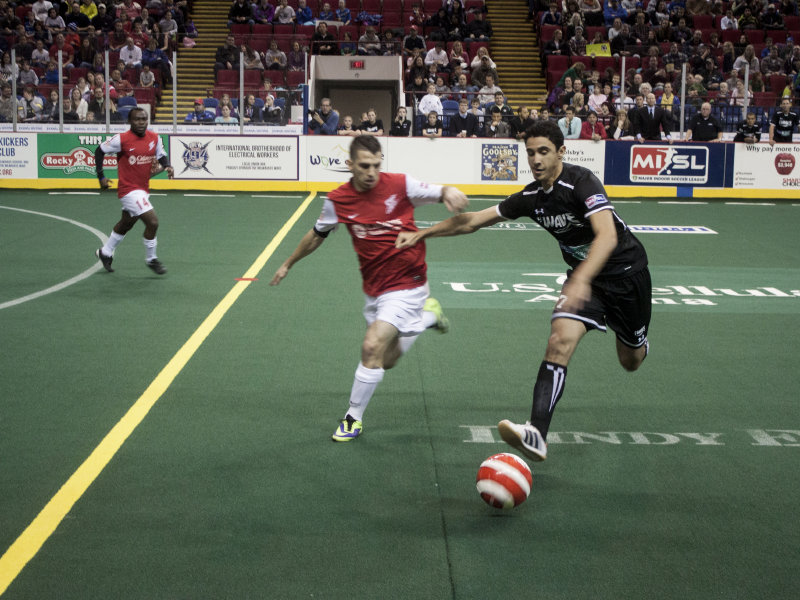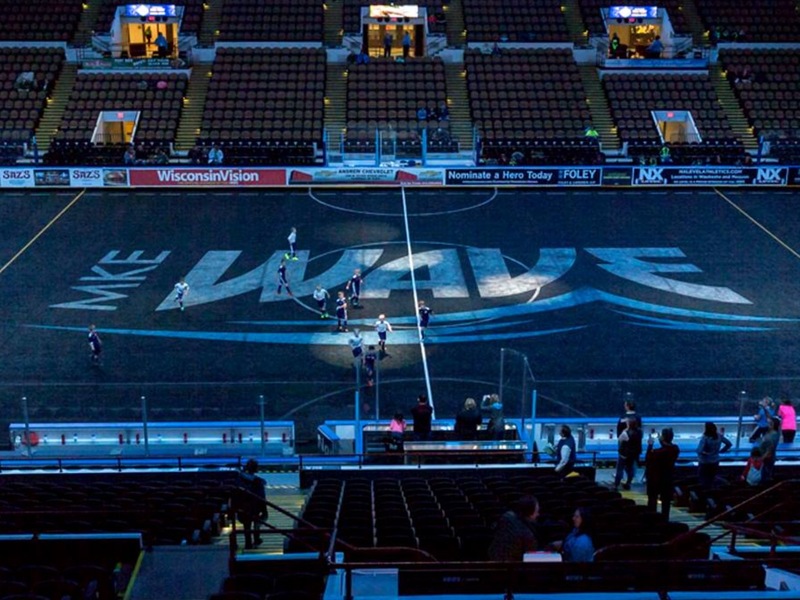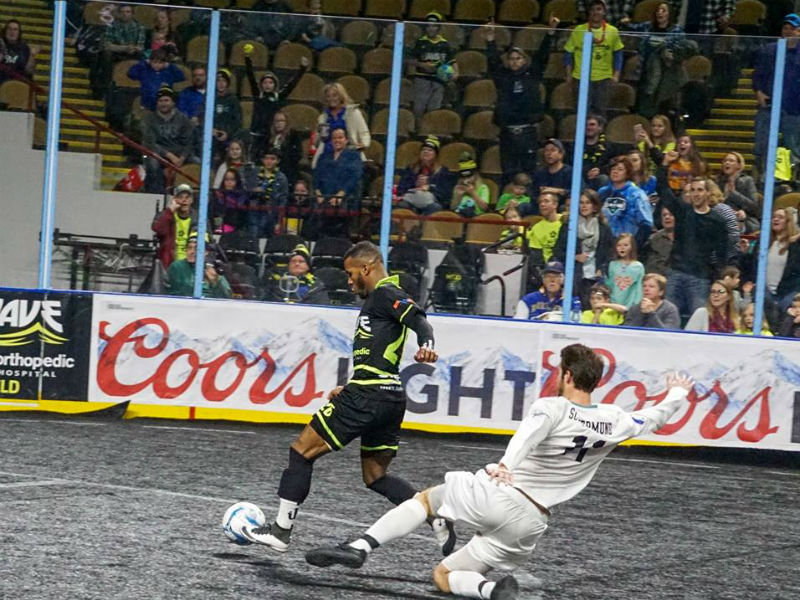Marcio Leite leaned against a cement wall leading off the turf at U.S. Cellular Arena, teammates playfully throwing a hand at his back, shoulder or backside. His arms crossed, he would smile, a chuckle interrupting his cadence whenever he was unexpectedly hit by a teammate as they walked by.
His weight was firmly on his right leg, his left bent at the knee as he was supported by the wall.
It’s a simple, thoughtless action, leaning against a wall. We do it all the time, whether we’re waiting for someone to come out of a bathroom or waiting in line for event tickets.
Yet when that right knee has been rebuilt on two separate occasions, it takes a little while for even the simplest of human mechanics to revert back to instinct.
Imagine trying to come back to the soccer field, especially when that knee was blown apart in back-to-back years playing the sport.
Professional athletes come back from injury all the time – it’s almost a rite of passage for many. Even serious injuries, like torn anterior cruciate ligaments, are sort of waved at as "no big deal."
But every human is different. So is every recovery. And in the midst of recovering from one reconstruction, you blow it out again; all bets of resuming a career are off.
"The second one was the one that really hurt me," Leite said. "Not my knee being hurt, but my heart was broken. I didn’t know what to do. I think my career’s done. It’s the same ACL. What just happened? I worked so hard to get back and this happened again?"
It’s why when the clock in the U.S. Cellular Arena struck zero on March 18, 2012, Leite sat on the Milwaukee Wave’s bench and cried.
The arena exploded in applause, Leite’s teammates and coaches ready to race together on the field as the team clinched its sixth Major Indoor Soccer League Championship – but Leite had to let it out, first.
He would be named the Championship Series Most Valuable Player, and it was the first championship he was truly a part of.
It was validation. He was all the way back from missing two seasons with injuries that could have ended his career.
"It was like a movie going back in my head, everything I had been through, doubting myself, can I be good again?," he remembered. "Once we won the championship I knew I could do this. At the end of the day, it was worth it.
"I said OK, I worked so hard to get here and I made it. It was a very proud moment to overcome all those things."
Not only that, he was back to the player he was, the player whose skill set made coach Keith Tozer’s jaw drop in his first Wave practice as a 21-year-old in 2006.
"It was like Gretzky taking the ice for Edmonton. It was like Magic taking the court for the Lakers," Tozer remembered. "That first practice was like … wow. I mean ... just … you could just tell he oozed ability."
"I just had a 24 hour flight, so I was pretty tired and the guys were like let’s go practice – I guess they wanted to see. Nobody had seen me play before," Leite said with a laugh. "I did OK. My legs were so heavy."
Tozer kind of smiled at Leite’s version of that first practice.
"Marcio could’ve traveled around the world three times and get no sleep and have a weight on his back. He just showed."
What’s funny is Leite nearly didn’t make it to Milwaukee in time for that moment.
The young Brazilian, who spoke very little English, had spent 15 terrifying minutes at O’Hare Airport in Chicago wondering where he was going once he got through customs.
As he exited the terminal, he felt completely alone in a facility which cycles through nearly 200,000 travelers a day.
No one was there to pick him up.
"I’m just there … and I don’t see anybody from the Wave and I started to freak out a little bit," he remembered with a laugh. "Fifteen minutes later (coach) Art Kramer showed up – yay! – it was a little relief. I was 21 years old, coming from another country. I don’t know anything, I don’t know anybody and you don’t see the team that is supposed to pick you up! I was going crazy!"
It’s a funny anecdote; the kind helps illustrate the humble beginnings of transcendent talents.
Yes, transcendent.
"Marcio could take over every game if he wanted to," Tozer said, without a hint of hyperbole in his voice, or on his face. "There’s times where he spreads the wealth more than he should. If he just wanted to, to just say you know what, I’m going to play balls out … he’d be … people consider him one of the top players in the league, but he’s got the ability to be (the best)."
It’s just that Leite chooses to play the game Tozer feels is best for the Wave – a team game, where the ball is shared, and everyone is a threat.
Until it’s absolutely necessary to unleash his greatest weapon, like last Saturday against St. Louis. He scored three times in the decisive fourth quarter, including on a 4-on-4 play that Tozer drew up on the fly for the kickoff. He asked Leite what side he wanted to take the ball. Leite picked the left side, and went down and scored in seven seconds.
"Everybody’s like oh, wow, we got that play!" Tozer said. "But I thanked him. I said you’ve got the ability to make the coach look good."
Leaning against that wall in the stadium, the bleachers rising high over Leite’s head, up to the rafters where championship banners hang. Hat tricks are nice, as are individual accolades. So are the compliments from peers and coaches.
They make him smile. But Leite speaks of bigger dreams as he’s planted firmly on that twice rebuilt right leg: Championship dreams.
"We are really a very good definition of a team – if one guy is not on, the other guy makes up for it," Leite said. "I think that when you really make history it’s not when you get an MVP. It’s when you win championships. The more you win championships, the better you are at the end of the day."
Jim Owczarski is an award-winning sports journalist and comes to Milwaukee by way of the Chicago Sun-Times Media Network.
A three-year Wisconsin resident who has considered Milwaukee a second home for the better part of seven years, he brings to the market experience covering nearly all major and college sports.
To this point in his career, he has been awarded six national Associated Press Sports Editors awards for investigative reporting, feature writing, breaking news and projects. He is also a four-time nominee for the prestigious Peter J. Lisagor Awards for Exemplary Journalism, presented by the Chicago Headline Club, and is a two-time winner for Best Sports Story. He has also won numerous other Illinois Press Association, Illinois Associated Press and Northern Illinois Newspaper Association awards.
Jim's career started in earnest as a North Central College (Naperville, Ill.) senior in 2002 when he received a Richter Fellowship to cover the Chicago White Sox in spring training. He was hired by the Naperville Sun in 2003 and moved on to the Aurora Beacon News in 2007 before joining OnMilwaukee.com.
In that time, he has covered the events, news and personalities that make up the PGA Tour, LPGA Tour, Major League Baseball, the National Football League, the National Hockey League, NCAA football, baseball and men's and women's basketball as well as boxing, mixed martial arts and various U.S. Olympic teams.
Golf aficionados who venture into Illinois have also read Jim in GOLF Chicago Magazine as well as the Chicago District Golfer and Illinois Golfer magazines.







